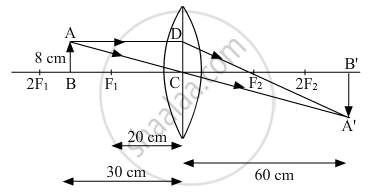Advertisements
Advertisements
प्रश्न
A student places a 8.0 cm tall object perpendicular to the principal axis of a convex lens of focal length 20 cm. The distance of the object from the lens is 30 cm. He obtains a sharp image of the object on a screen placed on the other side of the lens. What will be the nature (inverted, erect, magnified, diminished) of the image he obtains on a screen? Draw ray diagram to justify your answer.
उत्तर
Focal length of the lens, f = 20 cm
Object distance, u = −30 cm
According to the lens formula,
\[\frac{1}{v} - \frac{1}{u} = \frac{1}{f}\]
\[ \Rightarrow \frac{1}{v} = \frac{1}{f} + \frac{1}{u}\]
\[ \Rightarrow \frac{1}{v} = \frac{1}{20} - \frac{1}{30}\]
\[ \Rightarrow v = 60 cm\]
\[\text{ Magnification }, m = \frac{v}{u}\]
\[ \Rightarrow m = \frac{60}{\left( - 30 \right)} = - 2\]
Hence, the image formed is real, inverted and magnified.
APPEARS IN
संबंधित प्रश्न
A student is using a convex lens of focal length 18 cm to study the image formation by it for the various positions of the object. He observes that when he places the object at 27 cm, the location of the image is at 54 cm on the other side of the lens. Identify from the following diagram the three rays that are obeying the laws of refraction and may be used to draw the corresponding ray diagram.

(A) 1, 2 and 4
(B) 1, 3 and 5
(C) 2, 4 and 5
(D) 2, 3 and 4
What type of lens would you use as a magnifying glass? How close must the object be to the lens?
Distinguish between a convex lens and concave lens. Which of the two is a converging lens : convex lens of concave lens?
Explain with the help of a diagram, why the convex lens is also called a converging lens.
An object 4 cm high is placed at a distance of 10 cm from a convex lens of focal length 20 cm. Find the position, nature and size of the image.
Which type of lenses are:
thicker in the middle than at the edges?
To find the image distance for varying object distances in case of a convex lens of focal length 15 cm, a student obtains on a screen a sharp image of a bright object by placing it at 20 cm distance from the lens. After that he gradually moves the object away from the lens and each time focuses the image on the screen.
(a) In which direction-towards or away from the lens does he move the screen to focus the object?
(b) How does the size of image change?
(c) Approximately at what distance does he obtain the image of magnification –1?
(d) How does the intensity of image change as the object moves farther and farther away from the lens?
An object is placed perpendicular to the principal axis of a convex lens of focal length 20 cm. The distance of the object from the lens is 30 cm. Find (i) the position (ii) the magnification and (iii) the nature of the image formed.
Draw neat diagram to show the
Convergent action of a convex lens,
State the position of object, position of image, nature of image when: Convex lens is used as an erecting lens in terrestrial telescope.
